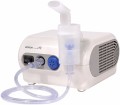Add to comparison |  |  |
|---|---|---|
| Omron CompAir C28 | Omron CompAir C24 | |
from $179.00 | from $52.30 up to $53.92 | |
| User reviews | ||
| TOP sellers | ||
Rich equipment. Low consumption and residual volume of medicine. Compatibility with a wide range of drugs. | Minimal loss of medication during inhalation. There is no possibility to adjust the particle size. Non-fixable cover of the nebulizer chamber. | |
| Type | compressor | compressor |
| Purpose | stationary | stationary |
Specs | ||
| Medicine container | 7 ml | 7 ml |
| Nebulization rate | 0.5 ml/min | 0.3 ml/min |
| Medium particle size (MMAD) | 3 µm | 3 µm |
| Noise level | 60 dB | 46 dB |
| Nozzles | adult mask children's mask nozzle for nose nozzle for mouth | adult mask children's mask nozzle for nose nozzle for mouth |
General | ||
| Case included | ||
| Power source | mains | mains |
| Dimensions | 170x103x182 mm | 142x72x98 mm |
| Weight | 1900 g | 270 g |
| Added to E-Catalog | may 2014 | may 2014 |